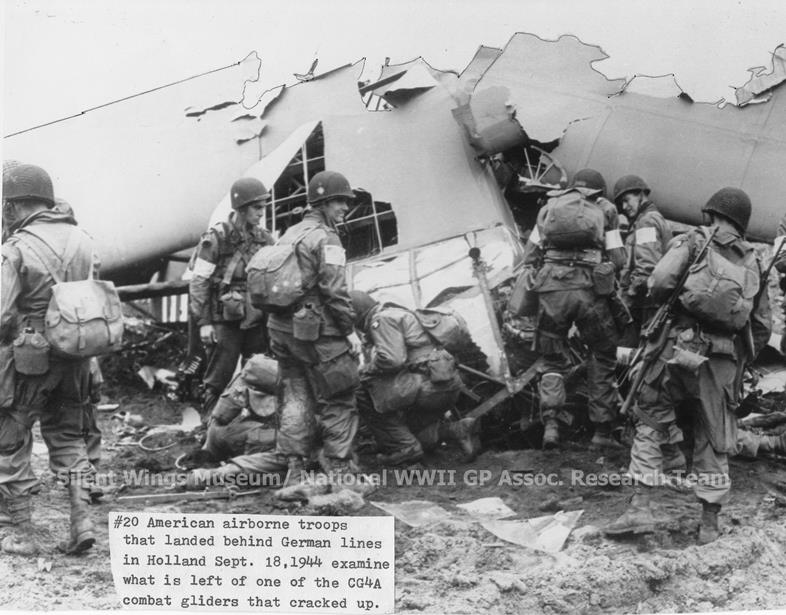
Silent Wsings Museum
PHOTO #20: Airborne troops worked frantically for seven hours to extricate four Americans, Thornton C. Schofield, Glider Pilot; airborne second lieutenant occupying the co–pilot’s seat*; an airborne First Lieutenant and a Sergeant riding in a jeep aboard the American CG–4A glider. Schofield's glider was rammed by another glider in midair at an altitude of about 150 feet while they were in the landing approach for Zonn, Holland during “Operation Market–Garden” September 17, 1944. Miraculously, all four escaped death. Schofield described the accident this way:
The crash was caused by a freak mid–air collision with another CG–4A glider, occuring at an altitude of about 150 feet. The other glider, apparently hit by ground fire was careening through the air with a dead or dying pilot at the controls, and slammed into the tail of my glider from the rear. The shuddering impact completely demolished the tail of my glider. Coming from the rear as it did, I was unaware of the impending collision and had no way of avoiding it. All I saw of the other glider was its left wing sweeping over the top of my glider after impact.
My glider shuddered violently, hovering momentarily, then nosed over and plunged toward the ground at an angle of about 75 degrees. First there was the terrible crunch as we hit the earth, then the terrible shock when the jeep slammed down on my back. My companion in the co–pilot seat was actually buried in the wreckage but hours later he was removed alive. His injuries were severe but mot fatal, thank God. The first lieutenant and sergeant riding in the jeep also survived the crash and with only minor injuries. Upon regaining consciousness, I was aware that I had nearly been catapulted out of the glider. My head and left arm had pouched a hole in the plexiglass windscreen. The photo vividly reveals this dilemma. It‘s impossible to describe one‘s feeling when plunging to earth from an altitude of over a hundred feet. Needless to say, it’s a mighty weird experience. It’s difficult to believe that anyone could survive a crash of that severity, but thank God for the miracle that saved all four of us.
Schofield, a member of the 75th squadron, 435th Troop Carrier Group,
dislocated his pelvis and left ankle, broke his left leg and suffered many other injuries.
Both gliders plummeted to the earth. F/O Schuffelberger died of his injuries. F/O Schofield and his passengers were able to make it out of the glider. Film footage is known of the actions to free the injured crew. One of the passengers was Lt. Critchell who wrote the book "Four Stars from Hell".
F/O Schuffelberger is buried at the American Cemetery at Margraten, Netherlands.
CLOSE